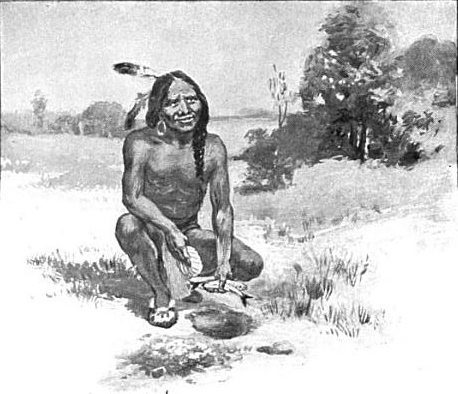Squanto was actually known as Tisquantum. Historians don't agree on when he was born, though they usually attribute January 1 as he birthday. As to what year he was born, that also is up for debate. Some say as early as 1580, others say 1592, and others say somewhere in between. Tisquantum was born around the area of Plymouth as a member of Patuxet tribe, which was a member of the Wampanoag Confederacy of tribes.
 |
| Common picture of Tisquantum (Squanto) |
His story begins when he was captured by Captain George Weymouth in 1605. Weymouth had been commissioned by the Plymouth Company (owned by Sir Fernando Gorges) to explore the coasts of what would later be called Massachusetts and Maine. Along with Tisquantum, Weymouth also captured four Penobscots, believing that his financial backers would like to see some Indians. Weymouth returned to England and presented Tisquantum to Sir Gorges. Sir Gorges then taught Tisquantum English, the ways of England, and hired him to return to the New World to be an interpreter and guide.
In 1614, Tisquantum returned to New England with Captain John Smith, but he was subsequently captured again. This time, it was by English explorer Thomas Hunt, who then sold Tisquantum into slavery in Spain. He escaped and lived with some monks for a couple years. He eventually made his way back to New England again in 1619, only to find that his entire tribe had been wiped out by a plague (commonly believed to be smallpox). With no home, he chose to live with the Wampanoags.
On March 22,1621, the Tisquantum was introduced to the Pilgrims, and went on to teach the Pilgrims to fish and cultivate the land. Chief Massasoit appointed Tisquantum to be liaison between the tribe and the Pilgrims. Tisquantum went on to lead members of the Pilgrims on exploratory missions in the area, help find lost members of the group, and continue to educate the Pilgrims on the land.
In the summer of 1621, Tisquantum and his companion Hobomok were sent to spy on Corbitant, a member of the Wampanoag tribe who was very anti-English. Corbitant harassed the two, and fearing for their lives, they tried to flee, but only Hobomok escaped. He appealed to the Pilgrims, and Miles Standish rallied a few men who marched to free Tisquantum. The Pilgrims attacked a Wampanoag village, but Corbitant had already released Tisquantum and fled by then.
Hobomok had been assigned to watch over Tisquantum because Massasoit didn't trust Tisquantum. He felt that Tisquantum had been getting too close to the Pilgrims. Massasoit's fears were realized when Tisquantum began to abuse his power by threatening the Wampanoags that the English would release plague to them if they didn't do what he said. Massasoit had been distrusting of him anyway, but that was the last straw.
In late November, 1622, Tisquantum was on his way back from a meeting of the Wampanoags and Pilgrims (whose relations had been deteriorating due to his own abuse of power) when he became gravely ill: bleeding from the nose and having a fever. A few days later, he died. Although most people assume it was smallpox, there are growing beliefs that he had actually been poisoned by the Wampanoags. One reason that smallpox seems odd is that he had been to Europe twice and had lived around English settlers for a year and a half. The reason so many of the Natives died of disease in this time is because they had no natural immunities built up against diseases from Europe. One would have thought that taking Tisquantum to Europe twice would have made him catch something, but apparently not. Either he was very lucky before, or someone gave him something to make him die.
Either way, his name lives on in history books as simply Squanto, the Indian who taught the Pilgrims to plant a fish with their corn and taught them how to fish. The truth though is always a little bit different than what is commonly remembered.
No comments:
Post a Comment